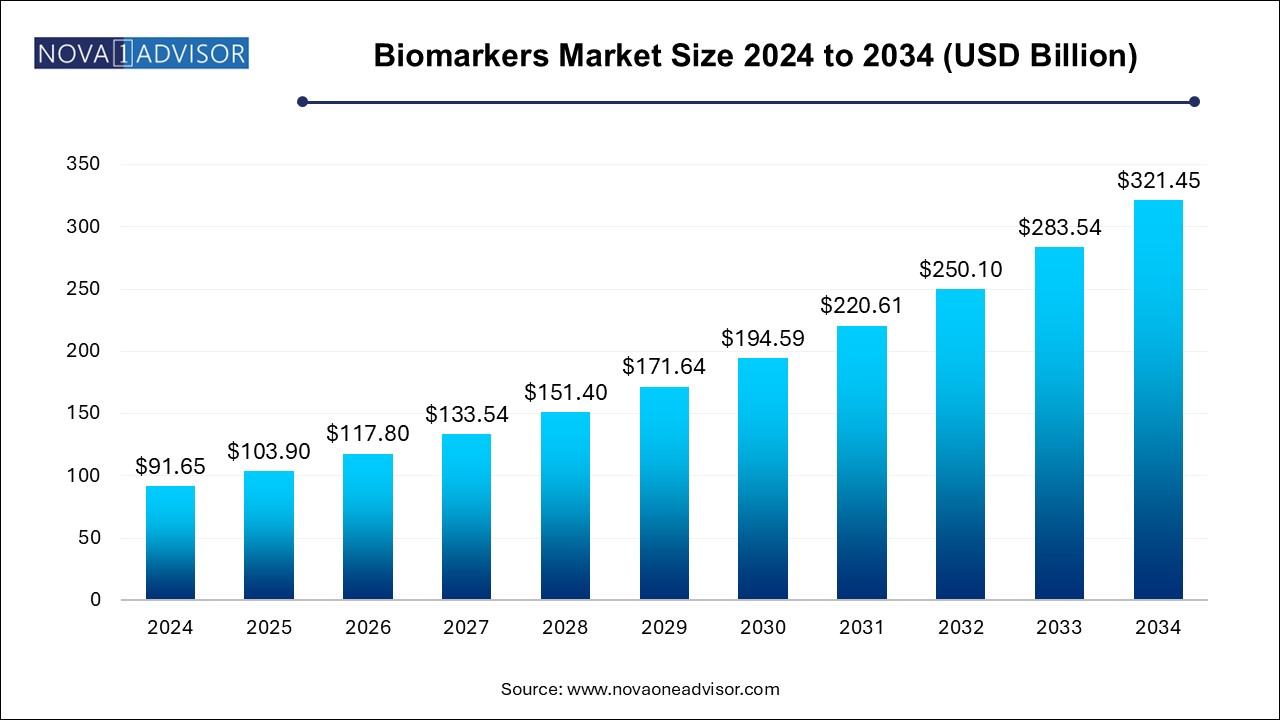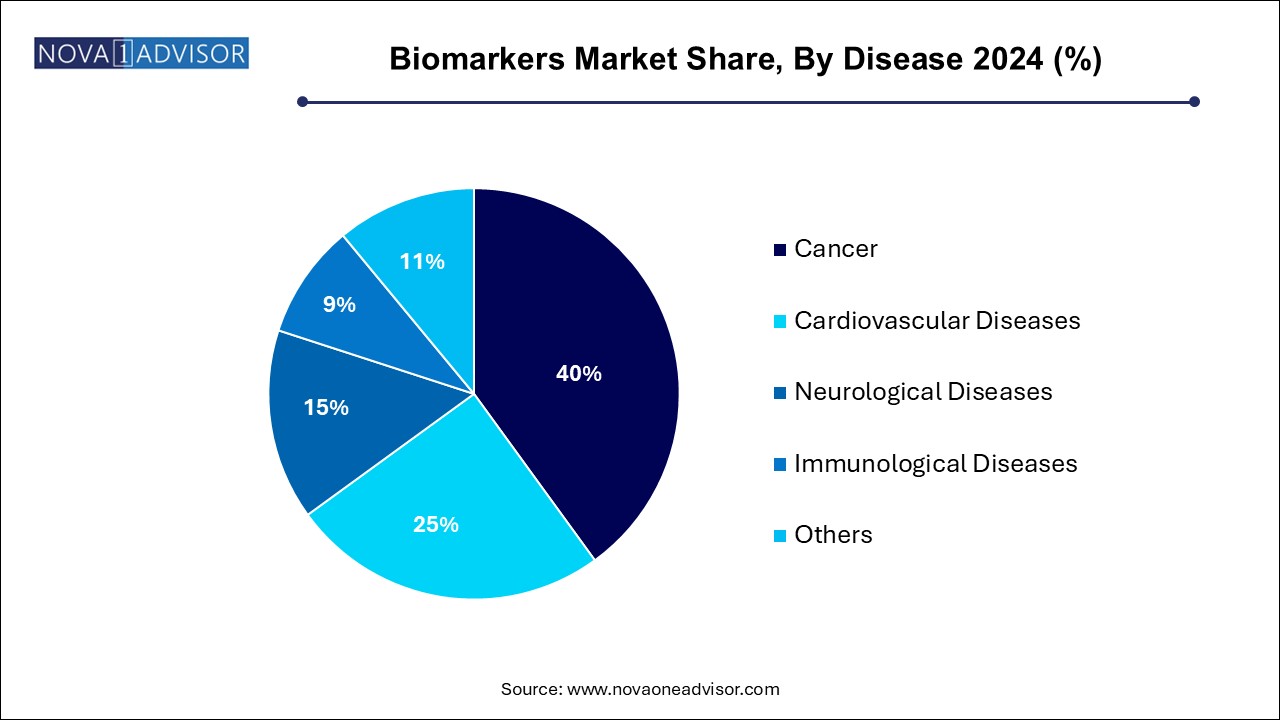The biomarkers market size was exhibited at USD 91.65 billion in 2024 and is projected to hit around USD 321.45 billion by 2034, growing at a CAGR of 13.37% during the forecast period 2024 to 2034.

| Report Coverage | Details |
| Market Size in 2025 | USD 103.90 Billion |
| Market Size by 2034 | USD 321.45 Billion |
| Growth Rate From 2024 to 2034 | CAGR of 13.37% |
| Base Year | 2024 |
| Forecast Period | 2024-2034 |
| Segments Covered | Type, Product, Application, Disease, Region |
| Market Analysis (Terms Used) | Value (US$ Million/Billion) or (Volume/Units) |
| Regional Covered | North America, Europe, Asia Pacific, Latin America, MEA |
| Key Companies Profiled | F. Hoffmann-La Roche AG.; Abbott; Epigenomics AG; General Electric; Johnson & Johnson Services, Inc.; Thermo Fisher Scientific Inc.; Bio-Rad Laboratories, Inc.; Siemens Healthineers AG; QIAGEN; Merck KGaA; PerkinElmer Inc.; Agilent Technologies, Inc.; Eurofins Scientific |
The rising prevalence of cancer, significance of companion diagnostics, investments in research, and significant innovations owing to ongoing research are anticipated to drive market growth. For instance, in February 2024, National Institutes of Health announced funding of USD 4 million to Eastern Virginia Medical School (EVMS) for research and development of biomarker for early detection of aggressive prostate cancer.
Increase in the prevalence of fatal diseases has been observed over the past few years, which includes cancer, diabetes, cardiovascular disorders, and other chronic diseases. One of the major factors leading to an increase in their prevalence is lifestyle changes. According to the American Cancer Society, in 2022, an estimated 1.9 million new cancer cases are expected to be registered in the U.S., accounting for 609,360 deaths. Breast and lung cancers were observed as the most common ones worldwide. According to the World Health Organization (WHO), in 2022, an estimated 236,740 new cases of lung cancer were expected to be reported in the U.S., accounting for 130,180 deaths.
The use of biomarkers in infectious disease diagnosis is anticipated to become increasingly common in the upcoming years. For instance, as per Frontiers in Microbiology in 2020 , potential MicroRNA-based biomarkers have been identified for the diagnosis of infections such as influenza infections, rhinoviruses, HIV, tuberculosis, malaria, Ebola, and Hendra virus. These are aimed at facilitating early onset of infectious diseases. Biomarkers are also under study for the diagnosis of SARS-CoV-2. They have a high prognostic potential, which is projected to play a crucial role in the diagnosis of asymptomatic cases that hinder the tracking of pandemic cases. Furthermore, the high stability despite freeze and thaw cycles gives them an added advantage.
Innovative treatments that combine biomarkers with new or existing medicines are continuously being launched. For instance, biomarkers can now be used for the treatment of neurological diseases to track brain health by measuring molecules. Recent developments are making treatment of neurological diseases easier, for example, the development of biomarker signatures. This has resulted in noninvasive testing, faster drug development, and early diagnosis. R&D is leading to the discovery of novel biomarkers.
The emergence of digital biomarker which assists pharmaceutical companies with contextual and supplementary information to conclude clinical trial decisions is further propelling growth of the market. IXICO plc, a digital technology-based company that has expertise in neurosciences, is collaborating with biopharmaceutical companies to validate clinically digital biomarkers and use them in regulatory compliant clinical trials. Another new biomarker technology published in PLOS Journal in June 2021 is bowel cancer relapse detection biomarkers with the help of ctDNA. This can be used as a prognostic tool that predicts the recurrence with a 100% accuracy rate, thereby enabling better treatment.
Leading players are focusing on introducing programs that can increase the commercialization of biomarker-based products. For instance, in November 2022, NeoGenomics, under the sponsorship of ImmunoGen, launched a novel biomarker testing program for patients with Epithelial Ovarian Cancer (EOC). This initiative targeted FRα in patients with platinum-resistant EOC and increased patient access to FDA-approved ImmunoGen's ADC, ELAHERE. Similarly, in April 2021, Amgen launched a Biomarker Assist Program for metastatic Non-Small Cell Lung Cancer (NSCLC) patients and increased access to testing.
The safety segment held the largest revenue share of 37.62% in 2024. Safety biomarkers can be used to customize therapies for patients, due to high risk of adverse reactions. They can predict or detect exposure effects or adverse drug events. Increase in the use of safety biomarkers in drug discovery & development is anticipated to boost market growth.Furthermore, an increase in population at high risk of developing various diseases, such as cancer, cardiovascular conditions, and kidney disorders, is expected to positively influence the market. Growing awareness of routine health checkups and lower drug attrition rates, which have been linked to biomarker-based therapies, are driving segment growth.
The efficacy biomarkers segment is expected to grow at the fastest CAGR from 2024 to 2034. Efficacy biomarkers aid in predicting patient responses to a specific drug. Despite the challenges in research, several findings have been reported on efficacy biomarkers. For instance, ATPase-copper Transporting β Polypeptide (ATP7B) is a biomarker used for detection of ovarian cancer. Furthermore, collaborative efforts between companies and academic institutes are expected to enhance the discovery of biomarkers. For instance, in June 2024, the National Cancer Institute announced the launch of ComboMatch platform trial which helps researchers to test efficacy of treatment combinations.
The consumables segment led the market in 2024. The growing emphasis on personalized and precision medicine has led to a growing need for biomarkers to identify specific disease markers and tailor treatment plans accordingly. This drives the demand for consumables used in biomarker discovery and validation. Moreover, the rising prevalence of chronic diseases such as cardiovascular diseases, cancer, and neurodegenerative disorders have led to an increase in consumption of consumables further driving market growth.
The services segment is anticipated to exhibit a lucrative CAGR over the projected period. Biomarkers are used in clinical trials for patient stratification, monitoring treatment responses, and assessing safety. Biomarker services support the design, implementation, and analysis of clinical trials, ensuring that biomarkers are effectively utilized for decision-making in drug development. Moreover, clinical laboratories and diagnostic service providers offer biomarker-based diagnostic testing services for various diseases. These services help in the accurate and reliable detection of biomarkers, contributing to early disease diagnosis and monitoring.
The drug discovery & development segment dominated the market in 2024. Biomarkers can be beneficial for accelerating drug development for certain diseases by predicting drug efficacy more easily than conventional clinical endpoints. Hence, they can help in identifying candidates that are likely to fail, thereby reducing drug development costs. Therefore, key players operating in this segment are focused on using biomarkers in drug development, which is leading to strategic alliances and thus driving the market.For instance, in June 2022, InterVenn Biosciences collaborated with the Foundation for the National Institutes of Health’s Biomarker Consortium and the Worldwide Innovative Network (WIN) Consortium, which aims to advance clinical trials, improve patient care, enhance precision oncology, and accelerate biomarker discovery.
The diagnostics segment is projected to register the fastest CAGR from 2024 to 2034. The increasing research focused on identification of new diagnostic biomarkers is fueling this growth. For instance, in February 2022, Japanese scientists found two new diagnostic tissue biomarkers, PHGDH and TRIM29, indicated for malignant pleural mesothelioma. These can be used to diagnose mesothelioma quickly and help doctors in differentiating between mesothelioma and other cancers.R&D in the segment confirms the development of novel biomarkers for early-stage detection of diseases such as Alzheimer's.
The cancer segment led the market in 2024 and is expected to retain its dominance from 2024 to 2034. The growth of this segment is attributed to an increase in demand for rapid & accurate diagnostic tools and rise in global incidence of cancer. According to Global Cancer Observatory, about 19.3 million new cancer cases were recorded in 2020, while around 10 million cancer deaths were reported in the same year. In addition, growth in research activities for discovery and development of novel cancer biomarkers is widening the scope for market growth. In June 2022, researchers from the Tokyo University of Agriculture and Technology developed a novel technique based on DNA computation for the identification of cancer miRNA patterns. By using low concentrations of the target biomarkers, the new technique can be a promising tool for early cancer diagnosis.

The immunological diseases segment is expected to attain the fastest CAGR from 2024 to 2034. This is mainly attributed to the increase in research aided with the rising prevalence of immunological diseases. For instance, in May 2024, according to article published by Boston Children’s Hospital, researchers have identified immune biomarkers that have helped in predicting COVID-19 severity and are mostly likely to help in future pandemics.Furthermore, increasing R&D in the renal biomarkers segment is anticipated to fuel the segment’s growth. For instance, in May 2022, researchers from the University of Houston, with the help of immunoproteomics-based discovery studies, reported potential biomarkers related to lupus nephritis related to clinical parameters, such as renal pathology indices. These biomarkers for lupus nephritis can be used to provide more reliable clinical blood tests for the disease, replacing kidney biopsy, which is a currently used invasive test.
North America led the market with a revenue share of 43.94% in 2024, due to high disease burden, technological advancements, increased consumer awareness, supportive government initiatives, and improvements in healthcare infrastructure. Local presence of key players is anticipated to increase the penetration of novel biomarkers. Major players operating in the market include Abbott; Merck & Co., Inc.; Johnson & Johnson Services, Inc.; Thermo Fisher Scientific, Inc.; and Bio-Rad Laboratories, Inc.; Many academic institutions, research centers, and universities are collaborating with key market players to develop biomarkers for diagnosing and monitoring numerous diseases. Increasing efforts for the development of digital biomarkers and increasing investments as well as collaboration activities are anticipated to drive growth.
Asia Pacific is anticipated to attain the fastest CAGR from 2024 to 2034. Factors such as high prevalence of cancer, surge in funding for discovery, low cost of clinical trials in developing nations, and rising research initiatives are expected to support regional growth. Several advancements in R&D by biopharmaceutical companies are expected to positively impact the market. For instance, in December 2021, Denovo Biopharma LLC announced the discovery of a novel genetic marker for a gene therapy-based medicine. This would facilitate treatment for patients with recurrent high-grade glioma, an unmet medical need with estimated survival of less than a year.
This report forecasts revenue growth at country levels and provides an analysis of the latest industry trends in each of the sub-segments from 2021 to 2034. For this study, Nova one advisor, Inc. has segmented the biomarkers market
By Type
By Product
By Application
By Disease
By Regional